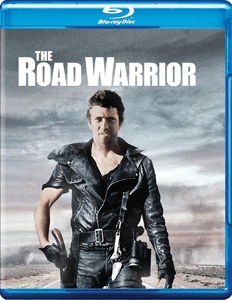“Mad Max 2: The Road Warrior” (1981) does what sequels do: It repeats the original’s structure but is bigger and better. The high-speed battle between the good and bad guys that caps the film — filled with practical stunts on a tanker truck, a bus, motorcycles and a homemade helicopter — was eye-popping at the time, and it’s still amazing today.
Director/co-writer George Miller pulls off a neat, somewhat accidental, trick – making both a sequel and a fresh pitch to newcomers. 1979’s “Mad Max” had its followers, so for them he builds up the world … sort of. The first film is set at the tail end of what we’d recognize as civilized times, as Mel Gibson’s Max works for the Australian highway patrol. He has a house and checks in at an office, and drives official vehicles.
That sweet, sweet oil
Though only a couple years must’ve passed in the saga’s chronology, as Max has the same leg injury, off-screen the last vestiges of the government collapsed and now we’re firmly established in anarchic times. It’s an accidental statement on how when the collapse happens, it will happen fast and with a whimper. Possibly it’s as simple as the government running out of sound money to pay its cops.

“Mad Max 2: The Road Warrior” (1981)
Director: George Miller
Writers: Terry Hayes, George Miller, Brian Hannant
Stars: Mel Gibson, Bruce Spence, Michael Preston
Over five days, RFMC looks at the five films of the “Mad Max” saga.
In a sense, “The Road Warrior” is a do-over. Despite having a more visually expansive world – an encampment of good guys around an oil derrick, and an encampment of nasty warriors building up an arsenal – Miller and his co-writers use a similarly simple plot to “Mad Max.”
It perhaps should be on a list of Basic Movie Plots: One side has oil, the other side wants to take it. Because “Road Warrior” doesn’t show many details of how these people live (Do they trade the oil for other goods? Do they use it to travel to markets?), the film operates as a timeless satire of Western civilization’s obsession with Middle Eastern oil.
The film was called “Mad Max 2” in Australia but “The Road Warrior” upon its USA release, apparently because the marketers didn’t want people to feel they had to watch “Mad Max” – and also to account for the possibility that they didn’t know about the first film. (It was the very early days of home video.)
Miller accounts for this with an introductory montage, including shots from the first film, that establishes Max’s bona fides as an emotionless vigilante without a name. (At least not one he wants to admit to. When his new allies ask his name, he doesn’t respond.) Viewers of the first film already know he’s gone cold, as he ends that story by murdering the last of his rivals, despite still nominally being a patrolman doing his job.
Action gets even more epic
“Star Wars” parallels continue, with Max being the Han Solo stand-in. After fulfilling a deal with one of the good guys (delivering him back home in exchange for fuel), he departs like Han before the Battle of Yavin.
“Mad Max 2” is both influenced and influencer, as it seems clear in retrospect that 1995’s “Waterworld” is “The Road Warrior” on Water. Notably, Tina Majorino’s Enola from that later film closely resembles the Feral Kid (Emil Minty).
The kid develops a bond with Max in this movie that seems more populated than the original, despite now being firmly in dystopian times in the Australian Outback. It feels slightly crueler in its violence – for example, introducing the saga’s staple of using your enemies as shields on the front of your vehicles.
Character interactions in the original have an accidental bonhomie that perhaps grows from the DIY filmmaking. “The Road Warrior” still has some of this – Miller might revel in spectacular carnage, but he doesn’t linger on suffering – but it also has a sicker sense of humor. For some reason, a couple of the main villains wear assless chaps, and one motorcyclist seems to have an effeminate male ride with him, either because he’s gay or because this world – like a prison – has a shortage of women.
This nasty dystopian world will always struggle to present warmth, so it’s nice when bits of human compassion come through, like with Max and the kid. Miller doesn’t exactly view character development as a necessary evil, but I admit it does feel secondary. As with the original, the strength of “The Road Warrior” is the action. Luckily, it’s spectacular.
“Mad Max” reviews:
Saturday, Jan. 4: “Mad Max” (1979)
Sunday, Jan. 5: “Mad Max 2: The Road Warrior” (1981)
Monday, Jan. 6: “Mad Max Beyond Thunderdome” (1985)
Tuesday, Jan. 7: “Furiosa: A Mad Max Saga” (2024)
Wednesday, Jan. 8: “Mad Max: Fury Road” (2015)


